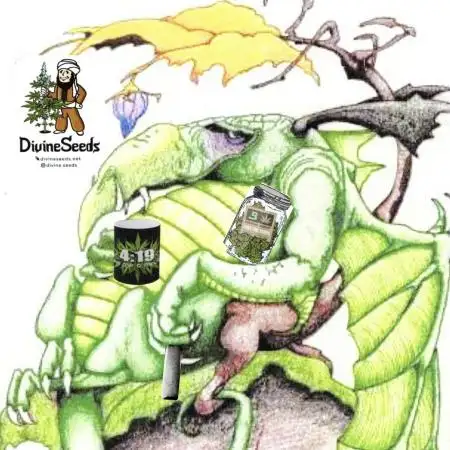By continuing to use the website or clicking Accept you consent to our cookies and personal data policy and confirm that you are at least 18 year old. For details please see Privacy Policy and Terms
Accept
Epson Salt
Marshmellow420started grow question 19h ago
Hey guys, I want to use Epson Salt on my plants. I am growing on coco and use osmosis water.
I never used this product before. If I apply like they say I have to use 50g on 20 liters. If I add that ammount the EC is around 3.5.
How would You guys handle this?
Open
likes
Answer
Still_Smoqanswered grow question 1h ago
The real answer would be who else on this site or do you know is using epsom salt? The only people I’ve ever heard swear by it were the occasional floweriest who do not grow weed. If you’re needing a magnesium I’d stick with a Cal/Mag supplement, not expensive and will last a very long time.
likes
Complain
00110001001001111Oanswered grow question 12h ago
coco is soilless. Nothing particularlly special about it despite the din of the peanut gallery. you provide a steady diet around the roots as the primary goal. it should waver much in concentratio or ratio except as a reaction to the plant in front of you.
depending on what Mg or S you already provide, i'd shoot for a total elemental ppm of 75 for Mg and 100-ish for S. You'll need to see what amount of Mg or S is added with your other products used and then if a little epsom salt is needed.it's a great way to add Mg and S.
However, if you do anything funky with the other nutrients, it may require more/less due to antagonistic/stimulative relationships with the other nutrient molecules. Assuming nothing else is overdosed or lacking, this should be a good level.
There are online calculators and apps that can convert for you.. i don't know the 'weighted average' percent of mass to shoot for relative to dosing.. that too in conjunction with overall concentraion (EC reading) could get you there too, but elemental ppm calculated from the labels is far more dependable and accurate.
https://www.angelfire.com/cantina/fourtwenty/articles/profiles.htm
Not recommending their suggestions.. just the calculator portion at bottom.. add up all your fertilizer as it's not a matter of one or the other but all that is added.
The numbers they give go a bit high in N and P in late flower accorindg to mj growers handbook, whatever tf that is. 250ppm is not necesary, lol... gauranteed toxicity unless you are somehow reducing it's avilability to the plant through pH or something fucked up like that. 250ppm for soilless/hydro context fertilizer options is insane.
What i've used for years and each time i deviate, i mostly come back to it as i see no improvements or reason not to...
90-130 N
40-60 P
180 k
100+ Ca
75 Mg
100 S
The lower N vales are as i enter flower phase... this is predicated on how the plant looks and not just some mindless change. if the plants look a bit too lush, i'll reduce N before flower phase. So, all of this is a ballpark and in the end how the plant grows and reacts is what matters most. Local variables will impact overall concnetration needed to keep up with local growth rate. The ratios won't change much, if at all. The goal is what is around the roots, not necessarily matching what enters the plant per day. Availability around the roots is the thing we optimize in hydro/soilless context in a precise and predictable way.
10% runoff is required... cannot stress it enough. If you don't religiously get at 10% runoff or more, you will get buildup of nutrients over time in the medium. might as well grow in soil at that point.
likes
Complain
Ultravioletanswered grow question 16h ago
Found this in old diary, thought it could help.
Calcium is a vital nutrient, performing a large number of vital roles in plant biology. It’s a crucial component in plant cell walls and helps transport other minerals from one side of cell membranes to the other. It’s also involved in some enzyme functions.
It’s what’s known as an immobile nutrient – once the plant has put it to use in one part of its structure, it can’t be relocated. That’s why we see deficiency in young leaves first – even if old leaves have more than enough, the calcium is fixed and can’t travel to where it’s needed.
Without enough calcium, those membranes become weak. The cell walls can’t control their permeability, resulting in the leeching of vital nutrients and an eventual waterlogging of affected cells. Mostly we see it as yellowing leaves, especially in newer growth, and fruit that becomes soggy and sodden from too much moisture.
Magnesium
Magnesium is just as important. It’s a key component in the construction of chlorophyll, arguably the most important of all chemicals inside a plant. Chlorophyll is the powerhouse of the plant. It’s responsible for turning oxygen and water into sugar, fueling all the plant's growth. Without it, there’s no chance of vigorous growth at all
Unlike calcium, magnesium is mobile and can be redeployed, so to speak, if the plant becomes deficient. As a result, magnesium deficiencies show in older leaves first, as the plant shifts its dwindling supplies to new growth.
Chlorosis is the defining trait of magnesium deficiencies. Leaves turn yellow, from the oldest to the youngest. It makes sense – after all, no magnesium, no chlorophyll.
Many Calmag solutions include iron, usually as a chelate. This is because many of the conditions that lead to soils poor in calcium and magnesium can also lead to low levels of iron, so it pays to cover all bases. Iron deficiencies also cause the same sort of chlorosis as magnesium deficiencies, so it sometimes pays to apply both at once.
(Chelation is a type of bonding of ions and the molecules to metal ions. It involves the formation or presence of two or more separate coordinate bonds between a polydentate (multiple bonded) ligand and a single central metal atom. These ligands are called chelants, chelators, chelating agents, or sequestering agents. They are usually organic compounds, but this is not a necessity.)
Others will include nitrogen, too, presumably because plants need a fairly consistent supply of the stuff, and a deficient plant is likely to spring to life, hungry and ready to grow, once the deficiency is corrected. This is not the case for all brands, so it pays to check – there are plenty of cases where a low or nitrogen fertilizer is preferred.
Calcium and magnesium work in concert within the plant, and so for many years it was assumed you had to ensure a good ratio of calcium to magnesium in order to get good growth from your plants.
We now know that it’s both simpler and more complicated than that. The ratio of calcium to magnesium in the soil isn’t important, provided there’s enough of both for whatever is growing.
However too much calcium can cause a drop in available magnesium. The two get along and readily bind to each other. You may well wind up with a magnesium deficiency if you go too hard with a purely calcium-based amendment. It’s why Cal-mag fertilizers are so useful – they prevent magnesium depletion while addressing both deficiencies at once.
Cal-mag is best used regularly. As calcium is non-mobile, it needs to be present in the soil for use all through the growing season. As flowers and fruit develop it’s especially crucial to keep everything well-fed and clicking along.
This is especially true if the weather has been erratic – plants draw calcium from the soil in water, so if the weather has alternated from very wet to very dry, it interrupts that uptake.
I’d suggest you apply Calmag as a supplement for heavy feeders through the growing season, especially if the weather has been sketchy. Depending on your location, this could be anywhere from early spring through to late fall.
Be mindful that plants with low fertilizer requirements won’t benefit from Cal-mag at all, and in fact, can be harmed by too much of it in the soil.
You can also use Calmag to treat either magnesium deficiencies or calcium deficiencies as they appear. Both show up as chlorosis, with magnesium depleting the green from old leaves and calcium from the young
Coco substrates have a few unique chemical properties that can cause problems if not treated. Chief among these is the high amount of potassium naturally found in coco. This potassium tends to swap places with calcium in nutrient solutions, resulting in too much potassium and not enough calcium in your system. Fortunately, treating with Calmag is a good way to remediate this. The magnesium has its own part to play in the complex chemistry happening at the root level, but together they can work to create a supportive growing environment for your plants.
How you apply the Calmag will determine how effective it is, as well as what you’re hoping to achieve.
As a preventative measure, you may never see the Calmag do its work. That’s the point – you are preventing the deficiencies from developing. If applied judiciously, it’s an invisible barrier, protecting you from crop failure and poor growth.
But if used to treat a diagnosed deficiency, the impact will be felt fastest with foliar application. Magnesium deficiencies will correct quite quickly. While already damaged leaves won’t revive, the grim march of yellow will stop almost immediately. Calcium deficiency is slower to spot, as it’s tied to the development of new tissue, but once you’ve corrected the problem the next wave of leaves or blossoms should be in good health.
Soil application takes longer for the plant to process, but it tends to be more enduring. It can take a few days for the minerals to work their way through a large plant, but once they do it’s a long-lasting result.
You can always have too much of a good thing, and Cal-Mag is no different.
At best, it’s possible to use Cal-mag to treat disorders caused by totally unrelated deficiencies, or even bacteria or fungus. While in these cases the Cal-mag itself isn’t going to cause too many problems, they certainly aren’t going to fix your problem.
More critically, both calcium and magnesium can spell trouble in too high concentrations. Too much calcium in the soil can result in the uptake of too much of other minerals and not enough of others, a tricky thing to detect. Magnesium sickness is easier to spot, leaving browning on the tips of new growth.
likes
Complain
Ultravioletanswered grow question 16h ago
Cook up your batch of homemade Cal-Mag supplements, using Epsom Salts (magnesium sulfate) and Calcium nitrate (a common fertilizer).
The ideal ratio is two parts calcium to one part of magnesium. A safe homemade Cal-Mag concentration would be 380ppm, with 260ppm Calcium and 120ppm Magnesium.
For reference, you would need around 6g of calcium nitrate and 4.5g of Epsom salts per gallon of water.
likes
Complain
HandsomeTerpzanswered grow question 16h ago
Hi,
good that you ask before applying that amount is way too much.
Epsom Salt is mainly used to supply magnesium and sulfur, but in coco you only need a very small amount because coco and RO water together already require a balanced nutrient plan.
A common dose is around 0.5–1 g per liter of water (so 10–20 g on 20 L), depending on your plants needs and the rest of your nutrient mix. Always check your base nutrients first, since most good coco nutrients already contain enough magnesium. If you overdo it, you risk nutrient lockouts. I’d recommend starting very low (e.g., 5–10 g per 20 L), measure the EC, and slowly adjust while watching how your plants respond.
My personal tip: you can also use Epsom Salt as a foliar spray. Mix it into a spray bottle at low concentration and apply under the leaves shortly before lights go out this way the plant absorbs magnesium directly and efficiently.
likes
Complain
AsNoriuanswered grow question 18h ago
EpsoM salt ;) i personally if see first signs add 50ppm, if i noticed late 100 ppm extra to few feedings.
Test you water base, weight like 1g of it, add it to 10 liters of water and retest. You will find amounts easy.
likes
Complain
John_Krameranswered grow question 18h ago
min-max for Mg = 35-70ppm + S per liter after that add fert
EC 3.5 = (1750ppm with 0.5 ratio) that could be too much !
golden rule is to start with 700ppm per L and then adjast for the next week
1 like
Complain
Alikibassissianswered grow question 18h ago
Personally, i would do PLENTY of research. Ive tried and failed dramatically with epsom salts and sworw down to never do it again.
If your going to do it, get plenty of research amd understanding in first before doing it, you might even change your mind.
likes
Complain














